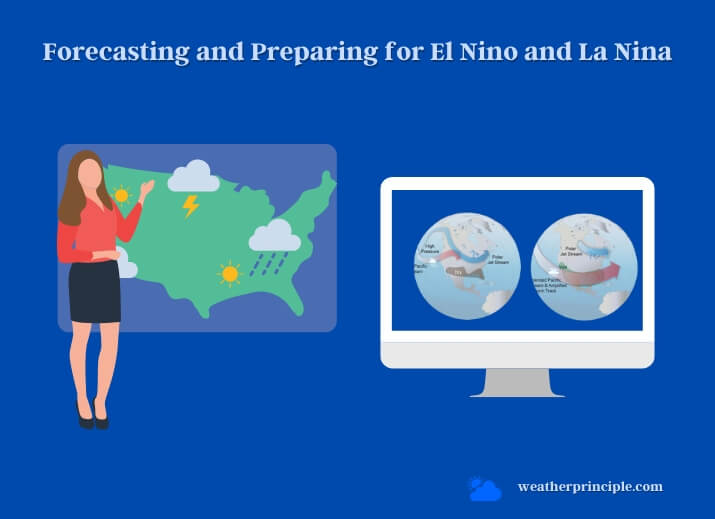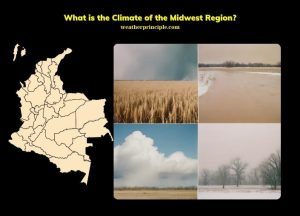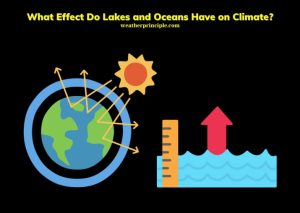Published on: May 11, 2023
Written by Kader Khan / Fact-checked by Shaown Khan
Our planet’s climate is a complex, interconnected system, influenced by various forces that interact and influence each other. Among these forces are the periodic climate oscillations known as El Niño and La Niña. These oceanic phenomena significantly impact global weather patterns, ecosystems, and human societies.
By examining the science behind El Niño and La Niña, we can better understand their formation, evolution, and effects. This knowledge allows us to develop more accurate forecasting techniques, prepare for their impacts, and adapt to a rapidly changing world.
El Niño: The Warm Phase
El Niño
The Role of Trade Winds
El Niño is characterized by a weakening of the trade winds, the east-to-west air currents that blow across the equatorial Pacific Ocean. These weakened winds allow warm surface waters to accumulate in the eastern Pacific, resulting in a significant rise in ocean temperatures.
The Ocean-Atmosphere Interaction
The warm waters of El Niño alter the interaction between the ocean and atmosphere, affecting global weather patterns. This phenomenon triggers extreme weather events, such as heavy rainfall and flooding in some regions, while causing droughts in others.
The Formation and Evolution of El Niño
Stages of Development
El Niño events typically develop in three stages: the onset, the peak, and the decay. The onset occurs when trade winds weaken, allowing warm waters to move eastward. The peak is reached when these waters reach their highest temperature, and the decay begins as trade winds strengthen, dissipating the warm waters.
The ENSO Cycle
El Niño is part of the El Niño-Southern Oscillation (ENSO) cycle, which also includes La Niña, the cool phase. The ENSO cycle typically lasts 3-7 years, with El Niño and La Niña events occurring irregularly.
The Effects of El Niño
Global Weather Patterns
El Niño influences weather patterns worldwide, causing intense rainfall, flooding, and landslides in regions such as South America and the southern United States. In contrast, areas like Australia, Indonesia, and parts of Africa may experience severe droughts and wildfires.
Ecological Impacts
El Niño events can cause significant harm to ecosystems, such as coral bleaching, species migration, and shifts in ocean productivity. These changes can have cascading effects, disrupting food chains and impacting local economies.
Economic and Social Consequences
The altered weather patterns of El Niño can lead to crop failures, infrastructure damage, and increased disease transmission, severely impacting communities worldwide. These events can cause billions of dollars in damages and affect the livelihoods of millions of people.
Historical El Niño Events
The 1997-1998 Event: A Case Study
The 1997-1998 El Niño event is considered one of the strongest on record, causing widespread devastation across the globe. It resulted in an estimated $45 billion in damages and claimed over 20,000 lives.
Other Notable El Niño Episodes
Other significant El Niño events include the 1982-1983 and 2015-2016 episodes, which also had widespread impacts on weather, ecosystems, and human societies.
La Niña: The Cool Phase
Behind the La Niña
The Strengthening of Trade Winds
La Niña is characterized by a strengthening of the trade winds, which pushes warm surface waters westward and allows cool, nutrient-rich waters to rise to the surface in the eastern Pacific Ocean. This results in a drop in sea surface temperatures, creating a cooler oceanic environment.
The Ocean-Atmosphere Rebalancing
During La Niña, the strengthened trade winds and cooler waters contribute to a shift in the ocean-atmosphere interaction, leading to distinct weather patterns compared to those during El Niño.
The Formation and Evolution of La Niña
Stages of Development
Similar to El Niño, La Niña events progress through the onset, peak, and decay stages. The onset begins with the strengthening of trade winds and cooling of the eastern Pacific waters. The peak occurs when the coolest temperatures are reached, and the decay phase starts as the trade winds weaken and sea surface temperatures begin to normalize.
The ENSO Cycle Revisited
As mentioned earlier, La Niña is part of the larger ENSO cycle. Although the cycle’s duration and intensity can vary, La Niña events generally follow El Niño events, helping to restore the balance in the ocean-atmosphere system.
The Effects of La Niña
Global Weather Patterns
La Niña’s influence on global weather patterns often contrasts with that of El Niño. Regions that experienced heavy rainfall during El Niño may face drier conditions, while areas that suffered from droughts may receive increased precipitation. La Niña can also contribute to colder winters in some regions, such as the northern United States.
Ecological Impacts
La Niña’s ecological consequences can be both beneficial and detrimental. The cooler, nutrient-rich waters in the eastern Pacific can boost marine productivity, supporting higher fish populations. The shifted weather patterns can lead to habitat loss and stress on certain species, resulting in altered ecosystems.
Economic and Social Consequences
La Niña events can also have considerable economic and social impacts. Although increased precipitation can benefit agriculture in some areas, the extreme weather events associated with La Niña, such as floods and cyclones, can cause infrastructure damage, disrupt transportation, and threaten human lives.
Historical La Niña Events
The 2010-2011 Event: A Case Study
The 2010-2011 La Niña event was one of the strongest on record, causing widespread flooding in Australia, Southeast Asia, and South America. The event also contributed to severe winter weather in parts of North America and Europe.
Other Notable La Niña Episodes
Other significant La Niña events include the 1988-1989 and 1999-2000 episodes, which also had considerable impacts on global weather patterns, ecosystems, and human societies.
Forecasting and Preparing for El Niño and La Niña
Modern Prediction Techniques
Climate Models and Observational Data
Scientific advancements in climate modeling and observational data have significantly improved our ability to predict El Niño and La Niña events. By analyzing historical data and utilizing sophisticated computer models, researchers can identify the likelihood of upcoming events and their potential intensity.

The Role of Artificial Intelligence
Artificial intelligence (AI) has also been employed in recent years to enhance prediction accuracy. Machine learning algorithms can analyze vast amounts of data, identify patterns, and make predictions based on these patterns, further improving our understanding and forecasting of El Niño and La Niña events.
Strategies for Adaptation and Mitigation
Agricultural Planning
By understanding the potential impacts of El Niño and La Niña on weather patterns, farmers can better plan their planting and harvesting schedules, select appropriate crops, and implement water management strategies to mitigate adverse effects on food production.
Infrastructure Development
Governments and communities can invest in resilient infrastructure to minimize the damage caused by extreme weather events associated with El Niño and La Niña. This includes building flood-resistant structures, reinforcing transportation networks, and developing early warning systems to prepare for potential disasters.
Disaster Management
Effective disaster management strategies are essential to minimize the human and economic consequences of El Niño and La Niña events. This involves developing emergency response plans, improving communication and coordination among various agencies, and educating communities about preparedness measures.
Conclusion
The Interconnectedness of Earth’s Climate Systems
The El Niño and La Niña phenomena illustrate the intricate interplay between the ocean and atmosphere and their far-reaching impacts on our planet’s climate. Understanding these complex systems is crucial for adapting to and mitigating the effects of these events, as well as addressing the broader challenges of climate change.
The Future of El Niño and La Niña Research
Continued research and innovation in forecasting techniques, coupled with advancements in artificial intelligence and climate modeling, promise to enhance our understanding of El Niño and La Niña events. This knowledge will empower us to better prepare for and adapt to the ever-changing climate landscape, ultimately improving the resilience of ecosystems and human societies worldwide.
Frequently Asked Questions
What causes El Niño and La Niña events?
El Niño and La Niña events are caused by fluctuations in the strength of trade winds, which in turn affect the ocean-atmosphere interactions in the tropical Pacific Ocean. These fluctuations lead to changes in sea surface temperatures, ultimately influencing global weather patterns.
How do El Niño and La Niña affect global climate?
El Niño and La Niña events alter the interaction between the ocean and atmosphere, impacting weather patterns worldwide. El Niño generally leads to warmer and wetter conditions in some areas, while causing droughts in others. Conversely, La Niña can result in cooler and drier conditions in some regions and increased precipitation in others.
Can El Niño and La Niña events be predicted?
Yes, scientists use climate models, observational data, and artificial intelligence to predict the likelihood and intensity of upcoming El Niño and La Niña events. While prediction accuracy has improved significantly in recent years, there is still room for further advancements.
How can we prepare for and mitigate the effects of El Niño and La Niña events?
Preparation and mitigation strategies include agricultural planning, infrastructure development, and effective disaster management. By understanding the potential impacts of El Niño and La Niña events, we can better plan for and adapt to the changes they bring, minimizing their adverse effects on human societies and ecosystems.
What is the relationship between El Niño, La Niña, and climate change?
While El Niño and La Niña events are natural climate oscillations, their effects can be exacerbated by climate change. Rising global temperatures and changing weather patterns can intensify the impacts of these events, making it more important than ever to understand their dynamics and develop strategies to adapt to and mitigate their consequences.



